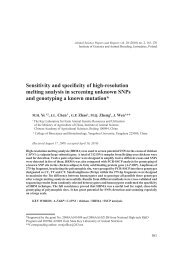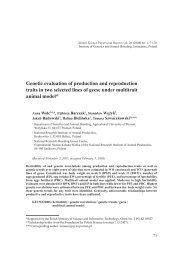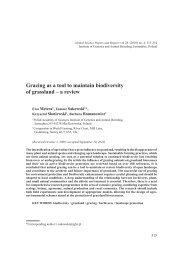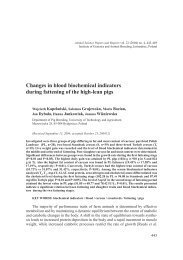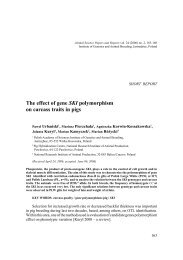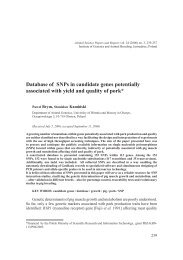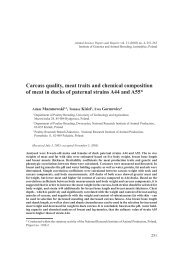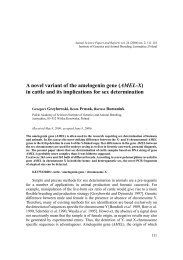Hoof size as related to body size in the horse (Equus caballus)
Hoof size as related to body size in the horse (Equus caballus)
Hoof size as related to body size in the horse (Equus caballus)
You also want an ePaper? Increase the reach of your titles
YUMPU automatically turns print PDFs into web optimized ePapers that Google loves.
A. Stachurska et al.<br />
– <strong>to</strong>e length (from <strong>the</strong> coronary rim <strong>to</strong> <strong>the</strong> centre of <strong>the</strong> <strong>to</strong>e);<br />
– hoof solar length (from <strong>the</strong> centre of <strong>the</strong> <strong>to</strong>e <strong>to</strong> <strong>the</strong> heel buttress l<strong>in</strong>e not <strong>in</strong>clud<strong>in</strong>g<br />
<strong>the</strong> heel bulb);<br />
– hoof width (at <strong>the</strong> solar side at <strong>the</strong> widest part of <strong>the</strong> hoof).<br />
To <strong>as</strong>sess <strong>the</strong> solar <strong>size</strong> of <strong>the</strong> hoof, <strong>the</strong> <strong>to</strong>tal hoof solar length and width w<strong>as</strong><br />
calculated. B<strong>as</strong>ed on <strong>the</strong> hoof and <strong>body</strong> dimensions, n<strong>in</strong>e follow<strong>in</strong>g ratios (%)<br />
illustrat<strong>in</strong>g <strong>the</strong> relative hoof <strong>size</strong>, were determ<strong>in</strong>ed:<br />
– <strong>to</strong>e length <strong>to</strong> height at wi<strong>the</strong>rs;<br />
– hoof solar length <strong>to</strong> height at wi<strong>the</strong>rs;<br />
– hoof width <strong>to</strong> height at wi<strong>the</strong>rs;<br />
– <strong>to</strong>tal hoof solar length and width <strong>to</strong> height at wi<strong>the</strong>rs;<br />
– <strong>to</strong>e length <strong>to</strong> chest circumference;<br />
– hoof solar length <strong>to</strong> chest circumference;<br />
– hoof width <strong>to</strong> chest circumference;<br />
– <strong>to</strong>tal hoof solar length and width <strong>to</strong> chest circumference;<br />
– <strong>to</strong>tal hoof solar length and width <strong>to</strong> cannon circumference<br />
Le<strong>as</strong>t squares means analysis of variance of <strong>the</strong> <strong>body</strong> and hoof traits, <strong>as</strong> well <strong>as</strong><br />
<strong>the</strong> hoof <strong>to</strong> <strong>body</strong> dimension ratios, w<strong>as</strong> performed with <strong>the</strong> SAS programme [2003]<br />
consider<strong>in</strong>g <strong>the</strong> breed and age of <strong>the</strong> <strong>horse</strong> <strong>as</strong> constant fac<strong>to</strong>rs and <strong>the</strong> error effect<br />
<strong>as</strong> random fac<strong>to</strong>r. The results of <strong>the</strong> analysis are presented <strong>in</strong> Le<strong>as</strong>t Squares Means<br />
(LSM) and Standard Errors (SE). Correlation coefficients (r) between <strong>body</strong> traits (1),<br />
between hoof traits (2), and between <strong>body</strong> and hoof traits (3) <strong>in</strong> breeds <strong>in</strong> <strong>to</strong>tal were<br />
calculated with Pearson’s procedure.<br />
Results and discussion<br />
The data presented <strong>in</strong> Table 1 show considerable differences <strong>in</strong> <strong>body</strong> and fore<br />
hoof parameters between breeds. The breeds are arranged <strong>in</strong> Tables accord<strong>in</strong>g <strong>to</strong> <strong>the</strong><br />
grow<strong>in</strong>g bon<strong>in</strong>ess <strong>in</strong>dex. In <strong>the</strong> result<strong>in</strong>g order, bigger PA mares are placed first and<br />
smaller PK mares <strong>as</strong> third, s<strong>in</strong>ce <strong>the</strong> former had relatively th<strong>in</strong>ner cannons than <strong>the</strong><br />
latter. The same arrangement w<strong>as</strong> applied while analys<strong>in</strong>g <strong>the</strong> hoof <strong>to</strong> <strong>body</strong> traits<br />
ratios. The hooves of PCB differed <strong>the</strong> most <strong>in</strong> <strong>the</strong> absolute <strong>size</strong>.<br />
The <strong>body</strong> dimensions were highly cor<strong>related</strong> with one ano<strong>the</strong>r, particularly <strong>the</strong><br />
chest with cannon circumferences (Tab. 2). The correlations with<strong>in</strong> hoof traits came<br />
out <strong>to</strong> be even higher.<br />
Tak<strong>in</strong>g <strong>in</strong><strong>to</strong> account three <strong>body</strong> dimensions, <strong>the</strong> cannon circumference correlations<br />
with <strong>the</strong> hoof <strong>size</strong> were <strong>the</strong> highest, <strong>the</strong> chest circumference correlations with <strong>the</strong> hoof<br />
traits were lower and respective height at wi<strong>the</strong>rs correlations <strong>the</strong> lowest (Tab. 3).<br />
Consider<strong>in</strong>g hoof dimensions relative <strong>to</strong> <strong>the</strong> <strong>body</strong> traits, <strong>the</strong> highest r values concerned<br />
<strong>the</strong> hoof width, <strong>as</strong> well <strong>as</strong> <strong>the</strong> <strong>to</strong>tal hoof solar length and width. All <strong>the</strong> r values were<br />
found significant.<br />
216



